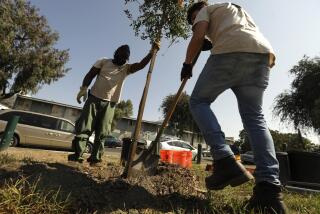Grim Profile of Children in Pasadena
- Share via
PASADENA — A profile of Pasadena’s children prepared by the City Commission on Children and Youth has revealed that the city faces problems characteristic of urban centers many times its size.
Among the findings:
* More than half of Pasadena’s children, 54.7%, live in only eight of the city’s 30 census tracts, Pasadena’s minority and lowest income neighborhoods.
* The gap between low-income and high-income families is widening. In a comparison between two census tracts, one in the affluent Linda Vista (where the median family income is $86,400) and another in Northwest ($18,300), the estimated earnings difference for families in the two areas could reach more than $68,000 by 1992. The city’s infant mortality rate of 18 deaths per 1,000 births is nearly double the county rate of 9.2 deaths per 1,000 births.
* More than a fourth, 28%, of the city’s children lack medical coverage of any kind.
Bolstered by such data, commission members appeared Tuesday at a Pasadena Board of Directors meeting to ask that the city lead a comprehensive program, spelled out in five pages of recommendations, to remedy the problems.
The recommendations include preparation of a 10-year plan to address the problems, an increase in city money for social service programs, use of federal block grants to enhance the lives of children and creation of a committee to investigate reasons for the infant mortality rate.
“The report contains a great deal of bad news on the surface,” said commission Chairman George Van Alstine, “but the good news is the people of Pasadena really want to do something to help the children.”
But the board balked at adopting the commission’s broad policy suggestions, citing concern that the city could be unknowingly committing itself to substantial financial costs and changes in ongoing city programs.
“We need to be quite clear what the implications are of what we’re going to do,” said Mayor William Thomson. “My concern . . . is financing the policy.”
Director Rick Cole agreed. “I want to see the city manager come back with some very specific steps to do it,” Cole said. “If it’s going to cost $6 million, I want to know where we’re going to get the money.”
The board directed the city manger to return with a plan on the report. In addition, the board adopted Director John Crowley’s proposal that encourages all city departments and commissions to consider children and youth in all programs and objectives.
The report was the work of a 12-member commission that was created in 1987 after the city’s centennial celebration the year before. Community activist Bessie Shenk persuaded the city to give the commission $15,000 to create a lasting gift for the city in place of the usual commemorative statue or plaque.
Commission members spent 15 months holding public hearings, culling data from census reports and sociological studies and interviewing more than 130 community activists, service providers and children to prepare the report.
At Tuesday’s meeting, commission Vice Chairman Bonnie Armstrong summarized the report’s findings.
The commission found that one out of every four Pasadena residents is under 19 years of age. The largest concentration of the city’s children and youth reside in the Northwest and West Central areas where the average income per household is less than $25,000 and blacks and Latinos outnumber whites. The percentage of women heading households in those areas is 15.3 compared to 3.3 for more prosperous neighborhoods in the city, the report states.
The Northwest and West Central areas are also the most dense and contain the highest number of low-income rentals, Armstrong said.
Pasadena also follows a statewide trend that indicates a widening of the gap between the wealthiest and poorest families, she said. In 1985, the city’s affluent areas had median family incomes of $31,3459, compared with $13,157 for families in the poorest areas.
The city also lacks a coordinated approach that views the varied problems of children as related, Armstrong said. Instead, social service agencies often find themselves assessing a child’s problems according to the type of care each agency is supposed to provide.
More to Read
Sign up for Essential California
The most important California stories and recommendations in your inbox every morning.
You may occasionally receive promotional content from the Los Angeles Times.













